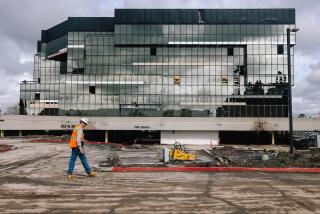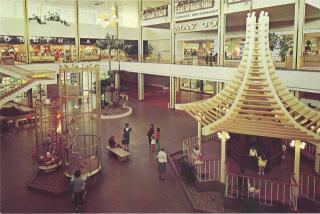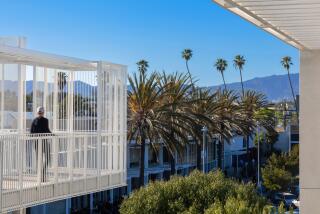Historic New England Buildings Increasingly Fill Today’s Needs : Reuse of Old Mills, Factories Has Become Economic Phenomenon in New England
BOSTON — Sturdy old mill and factory buildings, the heart of many New England communities since the Industrial Revolution, no longer symbolize dying industries.
Adaptive reuse of old buildings, which began as a fad in the early 1970s, has become an economic phenomenon with no sign of slowing in New England.
Specialized architects and developers are preserving history by turning older properties into new uses that include residential and commercial space, civic needs, classrooms and booming tourist attractions.
In Lowell, Mass., 500,000 square feet of the Lawrence Mill complex is the future home of Middlesex Community College and the University of Lowell’s engineering school.
Senior-Citizen Housing
An old mill alongside the Blackstone River in Central Falls, R.I., was modernized into senior-citizen housing. In Providence, a former rubber factory is home to airy office space and a trendy boutique mall at Davol Square.
The granite textile mills of Fall River, Mass., are a bargain-hunter’s mecca of factory outlet stores. The Portland, Me., waterfront is bubbling with new life because of intensive renovation and restoration of factory and warehouse space.
The Massachusetts Historical Commission estimated that more than $1 billion has been invested in rehabilitating historic buildings in the state since 1981.
“The popularity is increasing, not diminishing,” said John Judge, deputy director of the Massachusetts Office for Economic Development. “It has cultivated a whole class of architects who specialize in this kind of facility. They like the opportunity to take something designed for something totally different 100 years ago and adapt it for a new life.”
Central Location
Most mill and factory buildings are centrally located in the community, tend to be inexpensive, contrasted with new construction, and can be aesthetically pleasing.
“Remodeling them is an architect’s dream,” Judge said. “They’re wide open when you get inside. Exposed beams and brick, the hardwood floors--a lot of different looks and treatments are possible.”
The most vibrant example is in Lowell, a mill city that was dying in the early 1970s. The city, 20 miles northwest of Boston, began a dramatic reversal 12 years ago. The $13-million Lowell Development and Financial Corp., a nonprofit lending agency, formed a partnership with area banks to help businesses upgrade their properties in cooperation with preservationists. The area is a National Historic District attracting 800,000 visitors a year.
Lowell’s old Suffolk Mills, built in stages from 1832 to 1860, was turned into a five-building, 400,000-square-foot complex of high-tech space. Now called the Wannalancit Office and Technology Center, it employs 800 people.
The city is grappling with the need for a second wave of renewal: improving the living conditions for its minorities, for whom the initial gentrification effort brought only higher rents.
In Boston, building rehabilitation was a novelty for many developers until the Rouse Co. opened Faneuil Hall Marketplace 11 years ago near the city’s waterfront.
The Columbia, Md., firm transformed three 535-foot-long Greek revival arcades, which fell into disrepair in the early 1900s, into 400,000 square feet of choice office space and retail establishments.
There are 25 major renovations of factory, mill and warehouse properties in the Boston area. A virtual halt on new development in the 1970s and early ‘80s made rehabilitation the only option for developers. “Rehabs” now account for one-fourth of the new downtown office space.
David Kirk, director of the Boston Financial Consulting Group, said money lenders are much more amenable today to paying for adaptive reuse than they were five years ago. Ten years ago, Kirk said, they would not consider it.
“They always saw it as inherently more risky, and a lot of people passed. We’ve certainly gotten over that hurdle now that development is more plentiful,” he said.
“The thing that has helped this is that the cities are coming back into favor. Ten or 15 years ago, Boston wasn’t the great place, and wasn’t even trended toward the great place, it is today. There are other downtowns that are coming back into their own, which makes some of the more subjective aspects of reuse a lot more favorable and positive.”
One of the most unusual proposals is in North Adams, Mass. The Williams College Museum of Art is negotiating with the city and the Penn Central Corp. to turn the 20-building Sprague Electric Co. mill complex into the largest museum of contemporary art in the world. Penn Central owns the 750,000-square-foot complex.
Thomas Krens, director of the Williams College Museum of Art, said the sprawling complex would be a more than suitable site for the contemporary art museum because of its open space, which is required for properly displaying the exhibits.
“We’re getting more confident and ambitious with what we’re doing with mill buildings,” Kirk said. “All of this said, we still have millions of square feet of undeveloped mill space in New England that is still sitting and waiting.”
More to Read
Sign up for Essential California
The most important California stories and recommendations in your inbox every morning.
You may occasionally receive promotional content from the Los Angeles Times.










